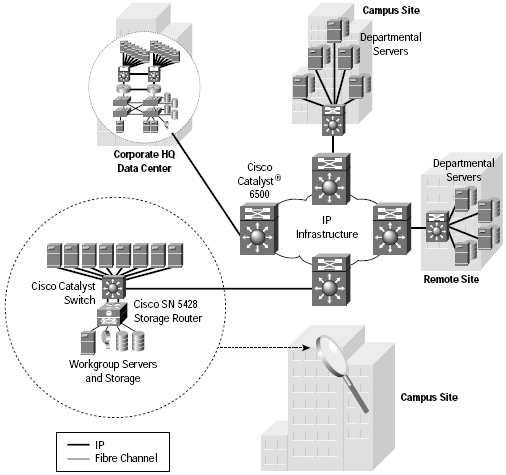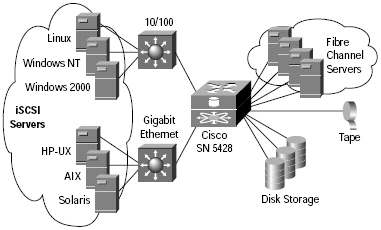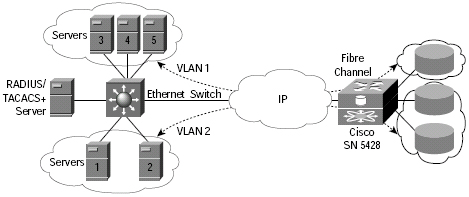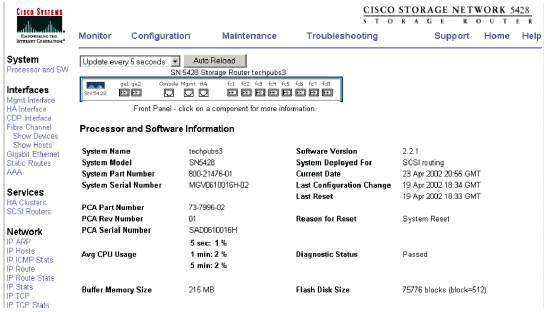|
|
Data Sheet
Cisco SN 5428 Storage Router
The Ideal Solution for Creating Workgroup SANs
Storage area network (SAN) deployment has eluded storage administrators because of the complexity and challenges of installing a SAN in small to medium businesses and enterprise departments. With the introduction of the Cisco SN 5428 Storage Router, storage/network/system administrators are finally provided with an easy way to migrate from direct-attached storage (DAS) to a more cost-effective and scalable networked storage solution. Unlike other workgroup SAN solutions that focus purely on Fibre Channel connectivity, the Cisco SN 5428 features a combination of both data networking and storage networking technologies. By using the Cisco SN 5428, your administrators can utilize their installed base of Ethernet and IP connectivity to deploy a SAN solution at a fraction of the cost of installing a new Fibre Channel network, including switches and host bus adapters (HBAs). The Cisco SN 5428 also provides advanced features including network boot, which allows servers to be booted from an external storage device across an iSCSI network.
The Cisco SN 5428 (refer to Figure 1) provides two Gigabit Ethernet ports, supporting Internet Small Computer System Interface (iSCSI), for connection to standard IP networks and eight Fibre Channel fabric switch ports. Storage administrators can now manage the workgroup SAN with familiar IP network management features such as Simple Network Management Protocol (SNMP) and virtual LANs (VLANs) and create secure storage pools by using familiar concepts such as access control lists, Remote Access Dial-In User Service (RADIUS) and TACACS+ authentication, logical unit number (LUN) mapping, LUN masking, and Fibre Channel zoning.
| Primary Features |
Storage Consolidation
As companies grow, traditional DAS systems can become increasingly expensive to manage and maintain. Consolidation of data onto a centralized storage system offers significant benefits in resilience, manageability, and scalability. A consolidated storage solution (refer to Figure 2) can significantly increase disk utilization by decreasing data duplication and increasing disk space efficiency. An effective consolidation strategy enables the sharing of a storage subsystem to every computing platform. It can also simplify backup and restore procedures, increase reliability and fault tolerance, and reduce management costs. The Cisco SN 5428 is the ideal product for those companies transitioning to a SAN to achieve the benefits of storage consolidation.
Figure 2
The Cisco SN 5428 Storage Router enables enterprise departments to migrate from DAS to a consolidated storage pool.

Key Benefits
Creating Workgroup SANs
Many small and medium businesses and enterprise departments have delayed implementation of a SAN because of the complexities and challenges involved. The Cisco SN 5428 addresses these limitations by enabling your storage/network/system administrator to build a cost-effective SAN. By using familiar concepts of access lists, RADIUS/TACACS+ authentication, VLANs, and SNMP, the Cisco SN 5428 can be the ideal starting point to create a workgroup SAN. All the benefits of a SAN, including increased storage utilization, centralized backups, easier addition of additional storage, increased amount of storage that each system administrator can manage, and reduced overall total cost of ownership, can be achieved with IP as the base technology. In addition, the Cisco SN 5428 is a full Fibre Channel switch that allows you to connect Fibre Channel storage and servers. The Cisco SN 5428 also offers Fibre Channel E_port and zoning features to build and segment a Fibre Channel fabric.
The Cisco SN 5428 provides the flexibility to determine how best to configure your servers and storage based on price/performance. Where the full performance of Fibre Channel is required, connect those servers directly to the Cisco SN 5428 Fibre Channel ports (refer to Figure 3). For those servers that have lower performance requirements or if the cost of a Fibre Channel HBA is cost-prohibitive, connect those through the Gigabit Ethernet ports and use iSCSI.
Based on both IP and SAN standards, the Cisco SN 5428 provides interoperability with existing local-area network (LAN), metropolitan-area network (MAN), wide-area network (WAN), optical, and SAN equipment. Storage/network/system administrators familiar with IP networking will be instantly familiar with the Cisco SN 5428 and its management interfaces.
Figure 3
The Cisco SN 5428 Storage Router in combination with Cisco Ethernet switches enables enterprise departments to migrate from DAS to a consolidated storage pool.

iSCSI Drivers
Cisco's iSCSI drivers, which reside on the server, are a key component of an iSCSI solution.These iSCSI drivers intercept SCSI commands, encapsulate them as IP commands, and redirect them to the Cisco SN 5428. These drivers are supported on an industry-leading number of operating systems, including:
Block-Level Access
The Cisco SN 5428 makes storage systems accessible at a block level across all leading operating systems. Storage connected through the Cisco SN 5428 will appear as though it is a locally attached disk. Your existing application software suites operate without modification.
Security
In addition to providing easy access to storage, the Cisco SN 5428 provides extensive security capabilities that are critical for controlling access to your valuable storage resources and company information. These security features, common in most IP networks, are new to the world of networked storage.
By taking advantage of standard IP technology for storage access, the Cisco SN 5428 allows you to use:
- Existing security infrastructure (firewalls, encryption devices, and others)
- Networking quality of service (QoS) and prioritization, which provides service-level agreements (SLAs) for your storage
- LUN masking and mapping, allowing servers to gain access only to specific LUNs
- Access lists, which provide Layer 3 protection to the LUNs that have been mapped
- Password protection, which provides further security to restrict access based on controls set by the administrator
- VLAN 802.1Q technology; VLANs constitute a common LAN network that can be logically segmented on an organizational basis, by functions, project teams, or applications to restrict access across Layer 2 (refer to Figure 4)
- VLAN Trunking Protocol, which manages and controls VLANs
- RADIUS and TACACS+, which provide authentication for the iSCSI login process; a server must complete the authentication process during iSCSI login to be granted access to the storage resources
Figure 4
VLAN Diagram—Although servers are on the same Ethernet switch, they can access storage devices only on their specific VLAN.

Leveraging the Advantages of IP
Total Cost of Ownership (TCO) is a growing concern for most storage/network/system administrators and their management. These costs arise from all aspects of storage management, including hiring and training of qualified personnel, backup and restoration, equipment upgrade, monitoring, learning new storage protocols, and interoperability.
The Cisco SN 5428 is the ideal product to leverage the technology and cost benefits of IP networks, offering the following benefits:
- TCP/IP protocols uniquely provide the level of security and management required for critical data stored on a consolidated storage pool.
- Servers connected to the Cisco SN 5428 Gigabit Ethernet ports can use the native 10/100 Ethernet ports on the server, eliminating the costs of a Fibre Channel HBA.
- When using Cisco's iSCSI products, iSCSI drivers are provided at no additional cost, minimizing the investment required for a workgroup SAN.
- The Cisco SN 5428 automatically adjusts the TCP window size to optimize storage performance using industry standards (RFC 1323).
- The fact that TCP/IP is one of the most interoperable and widely understood protocols reduces the learning curve of creating a workgroup SAN and eliminates the need to hire dedicated Fibre Channel personnel.
Scalability
The Cisco SN 5428 is designed as a one-rack-unit stackable device that can be combined to increase both performance and reliability. For increased reliability, you can stack up to two Cisco SN 5428s and interconnect them to form logical clusters. This ultra-high-availability architecture provides continuous access to your company information. For increased performance and connectivity for a greater number of servers or storage devices, you can scale performance with availability. If one unit in a cluster fails, you can configure another unit to automatically take over for the failed unit. You can stack Cisco SN 5428s to achieve the level of fault tolerance and reliability you require to support the most demanding applications.
Network Boot with iSCSI
System and network administrators are continuously looking for ways to reduce their costs. This applies to both the management of their networks and the equipment used in these networks. An advanced capability enabled by the Cisco SN 5428 addresses both of these. The network boot feature allows servers or clients to have their boot drive on shared centralized storage accessed over an IP/iSCSI network rather than being internal to the server or client. With Network Boot, management costs are reduced because "golden" copies of the boot images are centrally maintained and protected. This allows faster deployment of new servers in the event of a hardware failure. Furthermore, lower cost 1U/2U servers and the emerging blade servers can now be deployed without internal hard drives by using the network boot feature. An additional benefit from Network Boot is the capability to repurpose servers for different applications and operating systems based on a variety of conditions. Servers no longer have to be dedicated to a specific operating system or application. Because the boot images are managed remotely from the server, the administrator can select which boot image to utilize at a particular time.
Manageability
The Cisco SN 5428 provides full network management support through the industry-standard SNMP. The Cisco SN 5428 can be managed both out of band and in band across the Gigabit Ethernet ports. Standard Management Information Bases (MIBs) are available, ranging from iSCSI MIBs to the Fibre Alliance MIB. By using MIBs that are inherent to TCP/IP networks, the Cisco SN 5428 is supported by industry-standard SNMP system managers. No new learning curve is necessary.
Familiar Configuration and Management Interface
Installing the Cisco SN 5428 is easy. Simply connect it between your Ethernet network and Fibre Channel fabric and use the Cisco SN 5428 configuration wizard to install the router.
With the configuration wizard, IP-accessible storage is only minutes away. After you install the Cisco SN 5428, you can monitor and manage it with existing IP system managers, the Cisco SN 5428 Web-based graphical user interface (GUI) (refer to Figure 5), or the Cisco SN 5428 command-line interface that uses familiar Cisco configuration syntax. The configuration file from one Cisco SN 5428 can be exported to additional Cisco SN 5428s, providing very fast configuration updates in large storage environments.
Figure 5
Cisco SN 5428 Storage Router Graphical User Interface

Summary
The Cisco SN 5428 successfully combines IP intelligence with storage networking technology to provide the ideal solution for small to medium businesses and enterprise departments creating a SAN. The Cisco SN 5428 provides several crucial capabilities for today's storage networks, including:
- Facilitates storage consolidation for workgroups to provide reduced management costs, centralized backups, improved flexibility, and an overall reduction in the TCO
- Connects directly to Fibre Channel storage devices and extends that storage to more servers through cost-effective 10/100 Ethernet or higher-performance Gigabit Ethernet networks
- Provides full fabric switching capabilities to connect Fibre Channel storage and high-end servers
- Appears as locally attached storage devices, even when accessed over an IP network
- Provides levels of security and access control beyond what is currently available in traditional SANs by including Layer 2 and Layer 3 protection to resist against unauthorized access to your storage resources
- Uses the TCP/IP protocol suite for storage networking, thereby protecting your existing networking infrastructure investment
- Provides Network Boot capability, which allows a server to boot from a network drive on an IP network
- Takes advantage of existing management and configuration tools that are already well known and understood
- Based on industry standards, resulting in optimal interoperability with other networking and storage devices
Technical Specifications
Interface Specifications
Gigabit Ethernet
Hot-plugable, industry-standard small form plugable (SFP)
1000BASE-SX with MTRJ connector
Cable distances, short-wave optical
Fibre Channel
Eight F_ports, FL_ports, E_ports, TL, autodiscovering and self-configuring
2-Gbps full duplex, non-blocking, non-oversubscribed autodetection for compatibility with 1-Gbps devices
239 maximum number of switches
Hot-plugable, industry-standard SFP
Cable distances, short-wave optical
Management Interfaces
In-band management through Gigabit Ethernet
Ethernet 10/100 high availability
Cisco iSCSI Drivers
Windows NT 4.0 Server and Workstation (SP6A)
Windows 2000 Server and Professional (SP2)
Protocols and Standards
Internet Standards
Ethernet Standards
Fibre Channel Standards
Network Boot Requirements
PXE standard version 2.1 or higher
Minimum of 24k upper memory available
Dynamic Host Configuration Protocol/Trivial File Transfer Protocol (DHCP/TFTP) server
Windows 2000 Server or Advanced Server
Management Standards
RFC 1901 through 1908 SNMP v2c
RFC 2863 Interface Extensions MIB
Registered State Change Notification (RSCN)
Fibre Channel Remote Node ID (RNID)
Mechanical
Enclosure Type
Secure stacking with optional feet
Optional front or rear rack-mounting
Dimensions
Height: 1.75 in. (44.4 mm) 1 rack unit
Weight
Environmental
Operating Temperature: 23º to +113ºF (--5º to 45ºC)
Humidity: 15% to 80%, noncondensing
Altitude: 0 to 9843 ft (3000m)
Nonoperating Temperature: -13º to +158ºF (-25º to 70ºC)
Humidity: 5% to 95% noncondensing
Altitude: 0 to 15,000 ft (4570m)
Electrical
100 to 240 VAC, 50 to 60 Hz autosensing
Heat Output
Regulatory Agencies
Product Safety
AS/NZS 3260, TS001: Australia and New Zealand
Emissions
FCC Part 15 (CFR47): Class A (United States)
EN 55022: Class A (European Union)
CISPR 22: Class A (International)
AS/NZS 3548: Class A (Australia and New Zealand)
Immunity
Agency Certifications
Cisco Service and Support for Cisco Storage Networking
The Cisco SN 5428 Storage Router is supported by a service portfolio designed to align your unique business strategies and goals with a high-performance, high-availability storage networking system. Technical Support Services and Advanced Services covering the entire product life cycle are delivered by Cisco and via its ecosystem of best-in-class partners.
Technical Support Services are available through Cisco SMARTnet and SMARTnet Onsite support. Cisco SMARTnet support enhances your operations staff, providing them access to a wealth of expertise, both online and via telephone, as well as the ability to refresh their system software at will and a range of hardware Advance Replacement options. Cisco SMARTnet Onsite provides all Cisco SMARTnet services and complements hardware Advance Replacement by adding the services of a field engineer. This can be critical for locations where staffing is insufficient or unavailable to perform parts replacement activities.
Advanced Services for deployment of storage networking systems deliver consulting and assessment services to assist you with the development of your storage strategy and adaptation of storage networking to your applications. Delivered through Cisco and the Cisco ecosystem of best-in-class service partners, these services help customers deploying the Cisco SN 5428.